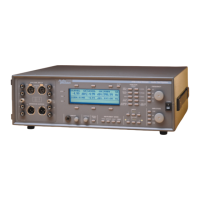In addition to the gen-mon path, the digital input signal can come from
any one of the external digital input connectors (XLR, BNC, or
Optical). This selection is made automatically depending on which
input has a signal applied to it. Only one digital input should be
connected at any time.
When the internal gen-mon paths are used, the generator outputs are
still active. Signal may still exist on the output connectors, and
measurements may be affected by loading or interference on the
generator outputs.
FUNCTION Keys
The FUNCTION keys (marked on Figure 3-1) select the particular
measurement to be obtained and displayed. This affects both the
displayed measurement and the internal configuration of the
instrument.
Most of the FUNCTION buttons choose the same measurement
function whether the analyzer is in analog or digital mode. The same
measurement will be taken, but from the analog or digital inputs,
depending on which mode is selected. These measurements are
marked with both a white dot and a blue dot.
Some of the FUNCTION buttons choose different measurements
depending on whether analog or digital mode is selected. In this case,
each measurement is marked with a white dot or a blue dot,
depending on which analog/digital mode is appropriate. The white
dot marks the measurement which is available in the analog domain,
and the blue dot marks the measurement which is available in the
digital domain.
Some FUNCTION buttons choose two different measurements within
the same domain. The first measurement is selected by the first press
on the FUNCTION button, and the second by a second press.
Some general setup parameters are located in the Main Panel or
Analyzer Only Panel for a specific measurement function, although
they apply to all measurement functions. These are the analog input
impedance, which can only be controlled in the analog LEVEL
function, and the digital interface parameters, which can only be
controlled in the DIGITAL I/O function.
& For more
information on
the LEVEL
function, see page
4-5.
& For more
information on
the DIGITAL I/O
function, see page
4-42.
3 Operation
Operational Overview Controlling the Analyzer
ATS-1 Dual Domain User's Manual 3-25

